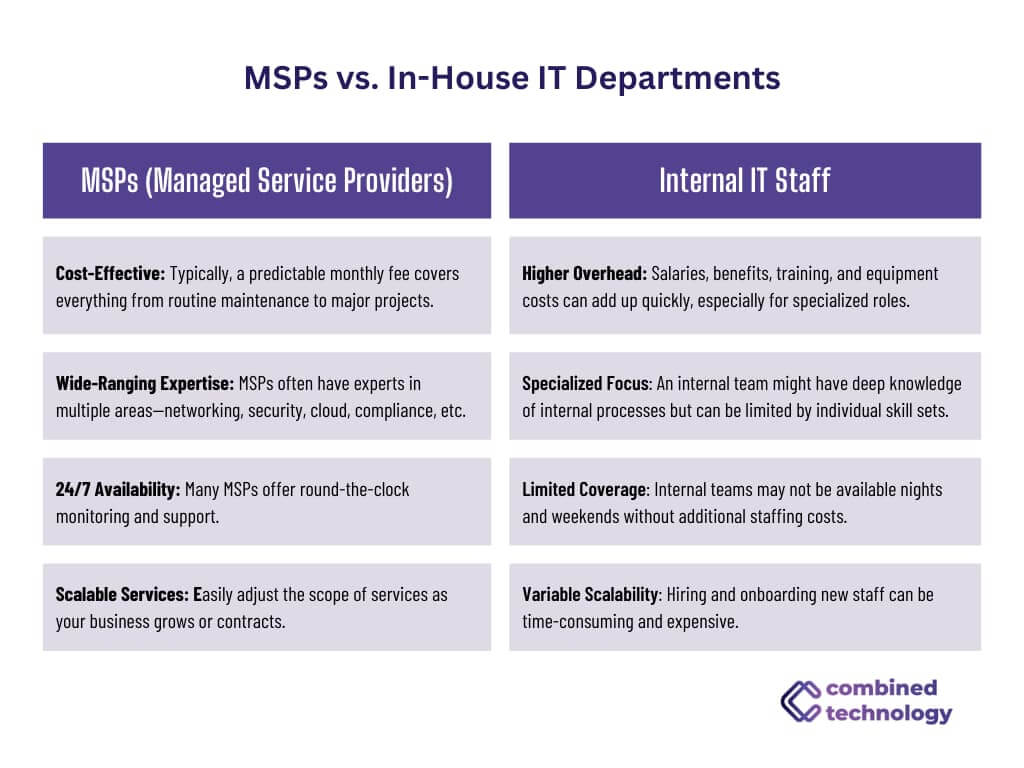Technology has become the backbone of modern business. From communication platforms to data management and cybersecurity, organizations of every size rely on IT solutions to stay competitive and efficient. However, building and maintaining a robust internal IT team can be expensive, time-consuming, and complicated. This is where Managed IT Services come in.
Let’s explore what Managed IT Services entail, how they’re typically priced, the various services offered, and why businesses need them. We’ll also dive into how Managed IT Services compare to Cloud Services, examine the Managed IT Services Model, discuss the historical evolution of these services, and look at how Managed Service Providers (MSPs) compare to internal IT staff.
A Brief History of Managed IT Services
Managed IT Services as we know them today emerged in the late 1990s and early 2000s, as businesses became increasingly dependent on technology. Initially, IT support was reactive—companies would call a technician when something broke. But as the Internet and digital solutions became integral to day-to-day operations, downtime became far more costly.
Proactive IT management soon gained popularity: service providers began monitoring infrastructure, implementing maintenance strategies, and preventing issues instead of merely reacting to them. Over time, these proactive services evolved into robust, all-inclusive packages offered at a predictable monthly cost. Today’s Managed IT Services incorporate advanced monitoring tools, cybersecurity safeguards, and strategic consulting—all aimed at optimizing IT performance and minimizing business disruptions.
What Are Managed IT Services?
Managed IT Services refers to the proactive support, monitoring, and maintenance of an organization’s IT infrastructure and end-user systems by a third-party provider (often called a Managed Service Provider, or MSP). Instead of hiring an entire in-house IT department or calling for IT help only when things break, businesses partner with an MSP to handle a range of IT responsibilities under a fixed or subscription-based model.
By entrusting day-to-day IT operations to specialists, companies can focus on strategic goals and core business objectives without worrying about network issues, server crashes, or cybersecurity threats.
Uncertain about which IT service model fits your business best?
Our team is here to help you navigate the options and answer all your questions so you can make the best decision for your business. Get in touch for a free assessment today!
Managed IT Services vs. Cloud Services
Although Managed IT Services often include cloud-based solutions, they are not synonymous with “Cloud Services.” Here’s the key difference:
- Managed IT Services: A broad, proactive approach to overseeing and optimizing an organization’s entire technology environment—servers, workstations, networks, cybersecurity, end-user support, etc. This may include on-premises infrastructure, cloud solutions, or a hybrid of both.
- Cloud Services: Typically refer to on-demand computing resources provided over the internet (e.g., Software as a Service (SaaS), Infrastructure as a Service (IaaS), or Platform as a Service (PaaS)). While many MSPs manage or resell Cloud Services, the cloud itself is just one component of an overall IT strategy.
How They Intersect
A Managed Service Provider may offer cloud-based email hosting, online backup solutions, or virtualization platforms as part of their service suite. However, Managed IT Services encompasses a wider scope, including on-premises hardware, software updates, compliance requirements, and ongoing technical support.
The Managed IT Services Model
Structure and Functioning
- Proactive Monitoring and Maintenance
- Continuous network monitoring and system health checks.
- Preventative measures like software patching and updates.
- Early detection of security threats and potential downtime issues.
- Dedicated Help Desk Support
- Employees can contact a help desk for troubleshooting, guidance, or issue resolution.
- Support can be tiered (Level 1, Level 2, etc.) to ensure the right expertise is assigned.
- Comprehensive Service Agreements
- Service Level Agreements (SLAs) outline response times, uptime guarantees, and other performance metrics.
- Predictable monthly costs cover a range of services under one agreement.
- Strategic Consulting
- MSPs offer guidance on technology roadmaps, future upgrades, and best practices.
- Regular reviews help align IT strategy with business goals.
- Scalability and Flexibility
- Services and resources can be scaled up or down based on fluctuating business needs.
- MSPs can quickly adjust to growth phases, seasonal demands, or mergers and acquisitions.
MSPs vs. In-House IT Departments
Many businesses wonder if they should build an internal IT team or outsource to an MSP. The right choice depends on organizational size, budget, and strategic needs. Below is a quick comparison:
| MSPs (Managed Service Providers) | Internal IT Staff |
| Cost-Effective: Typically, a predictable monthly fee covers everything from routine maintenance to major projects. | Higher Overhead: Salaries, benefits, training, and equipment costs can add up quickly, especially for specialized roles. |
| Wide-Ranging Expertise: MSPs often have experts in multiple areas—networking, security, cloud, compliance, etc. | Specialized Focus: An internal team might have deep knowledge of internal processes but can be limited by individual skill sets. |
| 24/7 Availability: Many MSPs offer round-the-clock monitoring and support. | Limited Coverage: Internal teams may not be available nights and weekends without additional staffing costs. |
| Scalable Services: Easily adjust the scope of services as your business grows or contracts. | Variable Scalability: Hiring and onboarding new staff can be time-consuming and expensive. |
In many cases, businesses use a hybrid model—retaining a small internal team for day-to-day tasks and partnering with an MSP for specialized services, advanced security, or large-scale projects.
How Are Managed IT Services Priced?
The pricing models for Managed IT Services can vary depending on the service provider and the scope of support needed. Common pricing models include:
- Per-Device Pricing
You pay a fixed rate for each device being supported or managed (e.g., desktops, laptops, servers, mobile devices). - Per-User Pricing
You pay a single monthly fee per user, typically covering all devices (desktop, laptop, smartphone, etc.) used by that individual. - Tiered Pricing
Providers offer tiered packages (e.g., basic, mid-level, and premium). As the tiers increase, so do the level of services provided. - All-Inclusive (Flat Rate) Pricing
A flat monthly fee covers a comprehensive range of services—proactive monitoring, maintenance, help desk support, and strategic consultations. - Customized or À la Carte Pricing
Businesses can select specific services to create a custom plan based on unique needs.
The Major Advantage: Predictability. This lets businesses budget effectively and avoid big surprises when emergencies arise.

What Services Do MSPs Offer?
Managed Service Providers offer a variety of services tailored to an organization’s specific needs. Some common offerings include:
- Network Monitoring and Maintenance
- 24/7 monitoring for performance issues.
- Routine maintenance, patch management, firmware updates.
- Help Desk and Technical Support
- Dedicated team to troubleshoot hardware/software issues.
- End-user support for both onsite and remote employees.
- Cybersecurity Solutions
- Antivirus software, firewalls, intrusion detection.
- Training programs and best practices to protect against cyberattacks.
- Data Backup and Disaster Recovery
- Comprehensive backup strategies, cloud-based or on-premises.
- Rapid recovery protocols to minimize downtime.
- Cloud Services Management
- Guidance and optimization for platforms like Microsoft 365, Google Workspace, AWS, or Azure.
- Ensuring efficiency, performance, and security in the cloud.
- VoIP and Unified Communications
- Voice services, video conferencing solutions, team collaboration tools.
- Streamlined communication across the entire organization.
- IT Strategy and Consulting
- Long-term planning, tech roadmaps, and upgrade recommendations.
- Aligning IT solutions with the organization’s overarching goals.
Why Do Businesses Need Managed IT Services?
Modern businesses operate in a landscape where technology is no longer just an operational component—it’s often the driver of innovation, customer engagement, and strategic growth. Here are some in-depth reasons why organizations of all sizes turn to Managed Service Providers (MSPs) for their IT needs:
- Predictable and Controlled Costs
- Reduced Capital Expenditures: Maintaining an in-house IT department can require significant upfront investment—servers, networking equipment, software licenses, plus ongoing hardware upgrades. By outsourcing to an MSP, you convert these capital expenses into predictable monthly operational costs.
- Budget Stability: Unexpected system failures, cyberattacks, or compliance-related fines can result in financial surprises. MSPs often offer fixed-fee or subscription-based pricing, enabling more accurate budgeting and minimizing unplanned emergency costs.
- Access to Specialized Expertise
- Broad Skill Sets: The IT landscape spans cybersecurity, network architecture, cloud infrastructure, data compliance, and more. It’s rare for one internal IT professional (or even a small team) to be an expert across all these domains. MSPs assemble teams of specialists with diverse skills—allowing your company to tap into a broader, deeper pool of expertise.
- Ongoing Training and Certification: MSP technicians stay current with rapidly evolving technologies and threats. This spares you from having to invest in continuous training, certification programs, and hiring new staff for specialized roles.
- Enhanced Cybersecurity and Risk Management
- Proactive Threat Detection: MSPs deploy advanced tools to monitor networks 24/7, spotting anomalies or suspicious activity before they escalate. This can significantly reduce the risk of data breaches or costly downtime due to cyberattacks.
- Regular Security Assessments: In addition to day-to-day monitoring, MSPs can conduct penetration testing, vulnerability scans, and compliance audits, ensuring your security posture is always robust.
- Incident Response and Recovery: Should a breach or outage occur, MSPs have structured incident response plans to contain the damage and restore operations quickly, minimizing business impact.
- Scalability and Flexibility
- Seasonal Demands: Some industries face fluctuating demands (e.g., retail spikes during the holiday season). MSPs can rapidly scale services, such as cloud resources or support staff, without long-term investments in additional hardware or personnel.
- Organizational Growth: As your company expands to new locations or hires more employees, an MSP can seamlessly adjust your infrastructure, network bandwidth, and licensing—saving you from the headaches of piecemeal expansions.
- Adaptability to Market Changes: Whether you’re pivoting to new products or integrating emerging technologies like AI and machine learning, MSPs help you adopt and manage these changes with minimal disruption.
- Proactive Maintenance for Minimal Downtime
- Continuous Monitoring: By using real-time analytics and automated alerts, MSPs can often identify hardware failures, software errors, or performance bottlenecks before they degrade user experience.
- Scheduled Maintenance Windows: MSPs plan upgrades, patching, and routine servicing during off-peak hours, reducing operational disruptions. This proactive approach extends system lifecycles and keeps employees productive.
- Strategic IT Roadmapping
- Long-Term Planning: Beyond daily troubleshooting, an MSP can act as a virtual Chief Technology Officer (vCTO), providing insights into emerging technologies, industry best practices, and future-proof architectures.
- Alignment with Business Goals: Through regular check-ins and technology audits, MSPs ensure that your IT investments align with your business objectives, whether those are increasing market share, enhancing customer service, or scaling operations.
- Compliance and Regulatory Support
- Industry-Specific Requirements: From HIPAA in healthcare to PCI-DSS in retail and financial services, many industries face stringent compliance rules. Non-compliance can result in hefty fines and reputational damage. MSPs are well-versed in these regulations and can guide you through audits and maintain required documentation.
- Audit Preparation: MSPs help gather logs, implement necessary controls, and remediate any issues ahead of official inspections, ensuring smooth compliance audits.
- Reduced Managerial and HR Load
- Less Staff Turnover Risk: IT roles can have high turnover, forcing your HR team to perpetually recruit, train, and retain talent. MSPs handle their own staffing, guaranteeing continuity of service.
- Simplified Vendor Management: MSPs often manage relationships with hardware and software vendors on your behalf—streamlining communication, problem resolution, and contract negotiations.
- Focus on Core Competencies
- Operational Efficiency: Every minute spent on IT troubleshooting is a minute lost from activities that directly generate revenue or enhance customer experience. MSPs free your internal resources to innovate and execute strategic initiatives.
- Leadership Freed Up: Executives and department heads no longer have to micromanage IT concerns, allowing them to concentrate on high-level growth strategies.
- Business Continuity and Disaster Recovery
- Robust Backup Strategies: MSPs implement multi-layered data backup solutions—often in the cloud—to ensure that critical information can be quickly restored in case of accidental deletion, hardware failures, or natural disasters.
- Rapid Recovery Protocols: Detailed disaster recovery (DR) plans outline the steps to restore systems and data, minimizing costly downtime. Testing these DR processes regularly ensures your business remains resilient.
From their historical origins as a reactive IT service model to today’s proactive, strategic approach, Managed IT Services have become an essential solution for businesses looking to optimize their technology infrastructure. While Cloud Services can be a component of these offerings, Managed IT Services encompass a far broader scope, ensuring end-to-end coverage—whether on-premises, in the cloud, or both.
By partnering with a Managed Service Provider, companies gain access to specialized expertise, predictable costs, and scalable solutions that can adapt to changing needs. Whether you opt for a hybrid approach (mixing in-house IT with an MSP) or fully outsource your IT department, embracing Managed IT Services can help you stay competitive, secure, and focused on your core business objectives.
If you’re looking to discover how Managed IT Services can benefit your business in Oklahoma, visit Combined Technology in Tulsa. Learn more about customized IT solutions designed to enhance security, improve productivity, and ensure seamless business continuity.
Get in Touch with Us

Safeguard Your Business with Tulsa's Top Managed IT Provider
At Combined Technology, we provide a flexible, tailored approach to meet your evolving IT needs. Safeguard your business against emerging threats with our expert-managed IT services and customized cybersecurity solutions.





